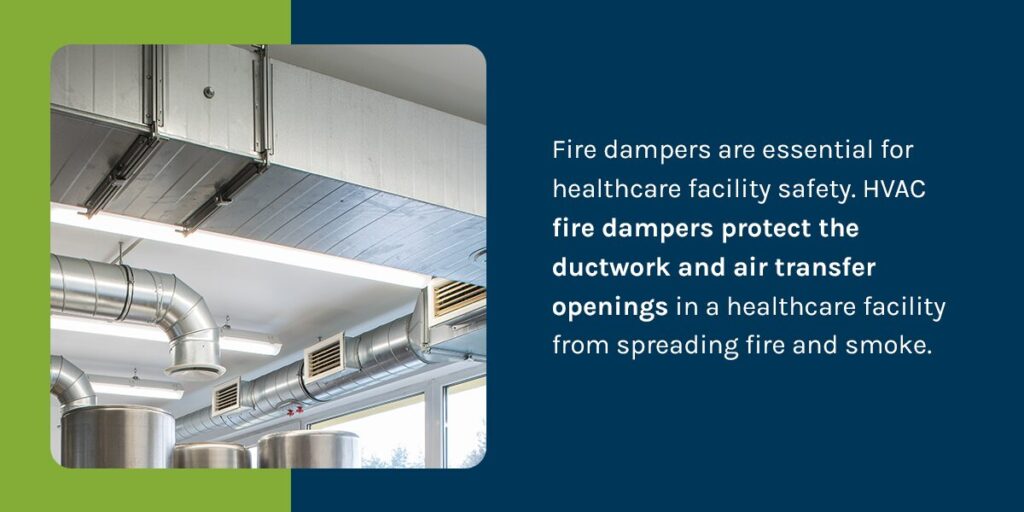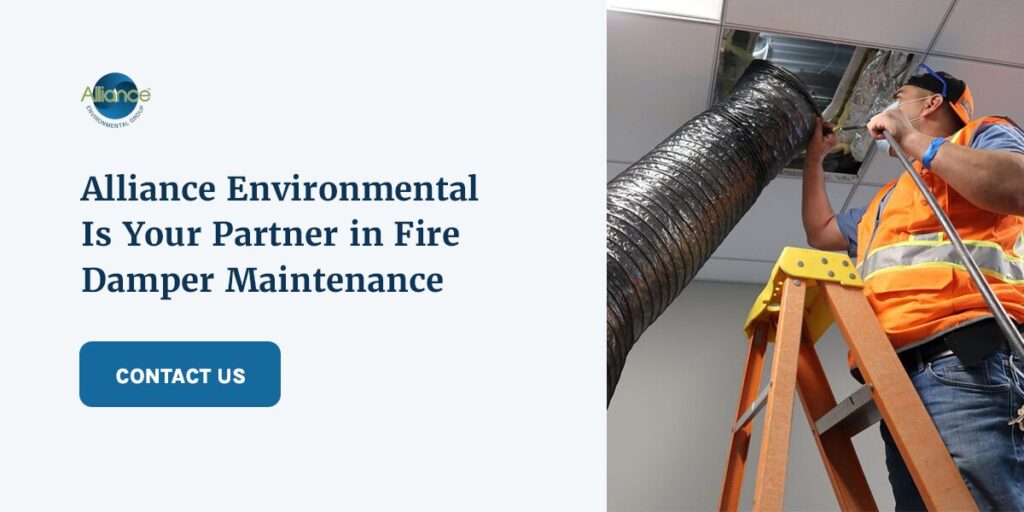- Careers
-
Search
- Call Us: 877-899-9867

Located throughout a building’s ductwork and HVAC system, dampers prevent fire and smoke from moving throughout the premises in urgent situations. Fire and smoke dampers are a crucial component of healthcare safety compliance, but damper maintenance is often overlooked.
Why do fire dampers matter in healthcare facilities? How can you ensure your fire dampers are compliant and work as intended? Here’s how to prepare fire dampers for healthcare facilities and maintain regulatory compliance so you can cultivate a safe environment for staff, patients and visitors.
Fire dampers are essential for healthcare facility safety. HVAC fire dampers protect the ductwork and air transfer openings in a healthcare facility from spreading fire and smoke, giving occupants more time to leave the building during a fire so firefighters can access it with ease. Here’s how it works:
In fire emergencies, the leading cause of death is smoke and toxic gas inhalation. Maintaining your facility’s smoke and fire dampers can, therefore, save lives. As they are placed in the ductwork that runs throughout an entire building, they are essential for providing better protection in urgent situations.

Fire dampers also play an important role in a healthcare facility’s air quality. Since fire dampers provide air-tight closures for a building’s HVAC system, they help the system function properly. They play a role in maintaining a facility’s humidity levels, circulating air and replacing contaminated air to increase patient comfort. For this reason, the Centers for Medicare & Medicaid Services include fire dampers as part of their healthcare regulatory compliance standards.
By helping HVAC systems replace contaminated air, fire dampers can also help mitigate biohazard risks in healthcare facilities. When you properly manage your facility’s fire dampers, you ensure contaminated air doesn’t replace conditioned air. Inoperable fire and smoke dampers can significantly impact infection control, making it crucial to maintain the dampers in your healthcare facility to reduce the spread of infectious diseases.
It’s important to conduct regular fire damper maintenance, as fires can significantly impact insurance premiums and claims. Fire is one of the most dangerous, destructive elements that can affect any property.
The challenges and costs of rebuilding your facility can lead to closures and financial instability. Fires are also a huge source of expensive insurance claims. Since HVAC fire dampers help reduce the spread of fire and its impact on insurance, ensuring their operability is crucial.
Insurance companies often require proof of damper testing when assessing claims for fire damage — following compliance regulations can help.
Learn the causes and consequences of fire damper failure and how to prevent it:
Healthcare facilities can prevent fire damper failure with regular HVAC fire damper cleanings and scheduling maintenance to determine if repairs are needed. Cleaning any dirt or debris can ensure the fire damper closes properly and functions.
What are some common misconceptions about fire dampers?
The fire dampers that are best for your facility will depend on various factors, but compatibility with your HVAC system will be the most important. Consider the following when choosing the appropriate fire damper services for your facility:
At Alliance Environmental, we offer several fire damper solutions for healthcare facilities, helping organizations just like yours maintain a safe environment. Having a reliable partner on your side to supply professional fire damper inspections and repairs is crucial, especially because the National Fire Protection Association has strict fire damper testing requirements.
With over 25 years of experience and more than 200,000 jobs complete, we can help your facility ensure fire life safety, indoor air quality and more. Explore our solutions for commercial properties and contact us today to learn more.
